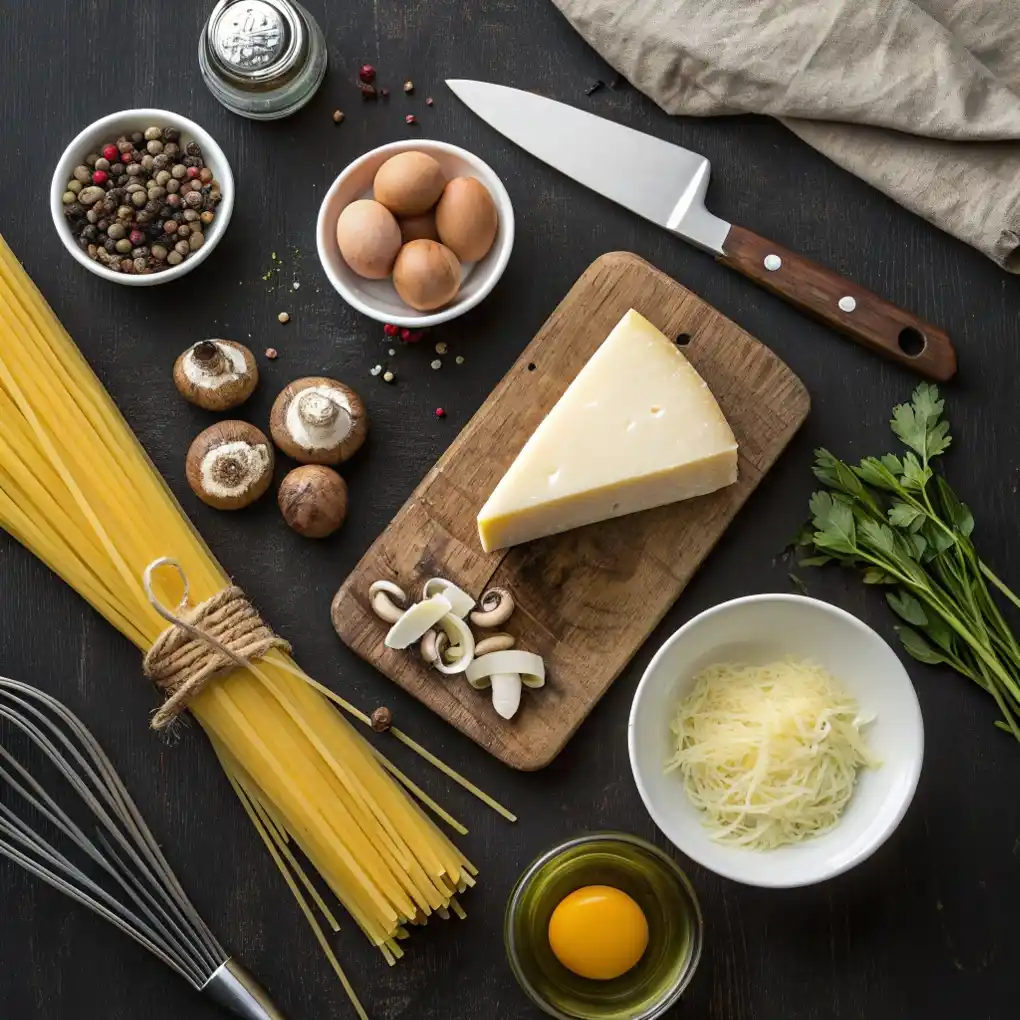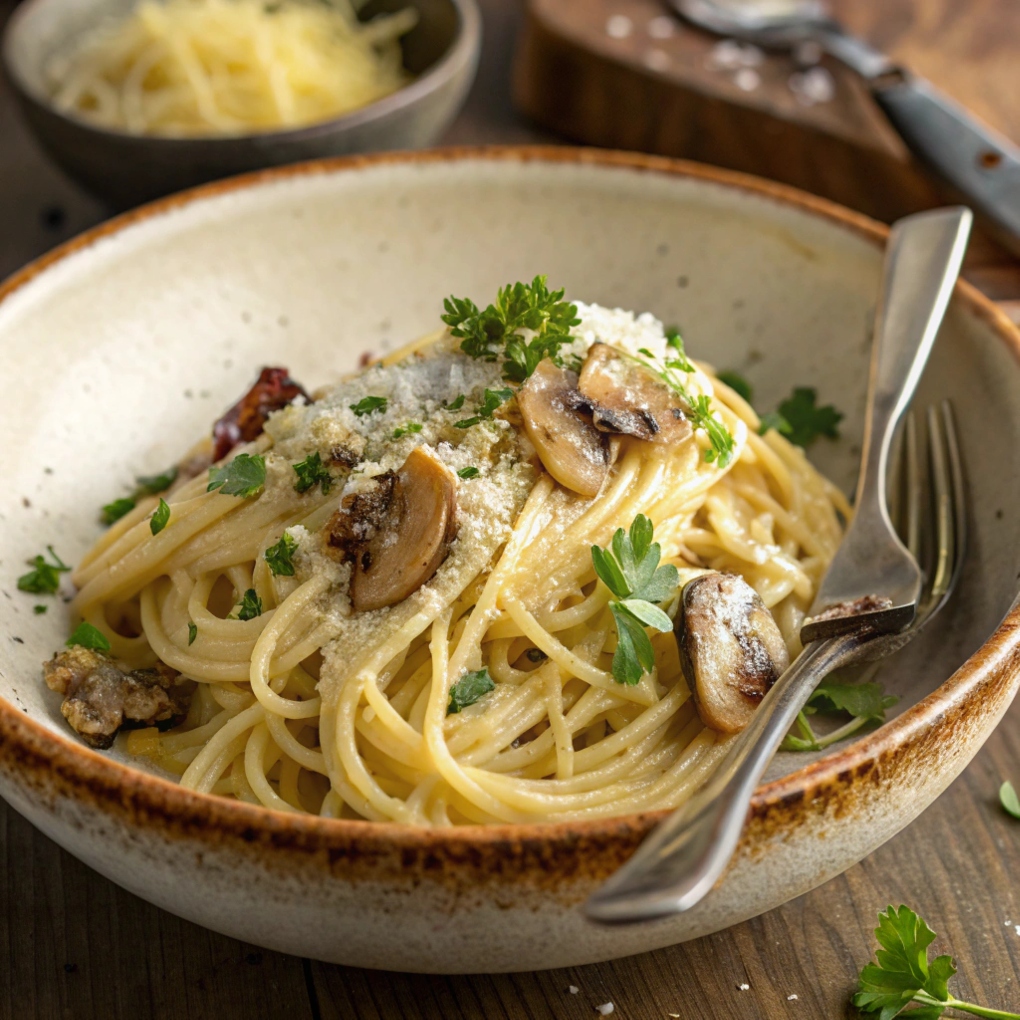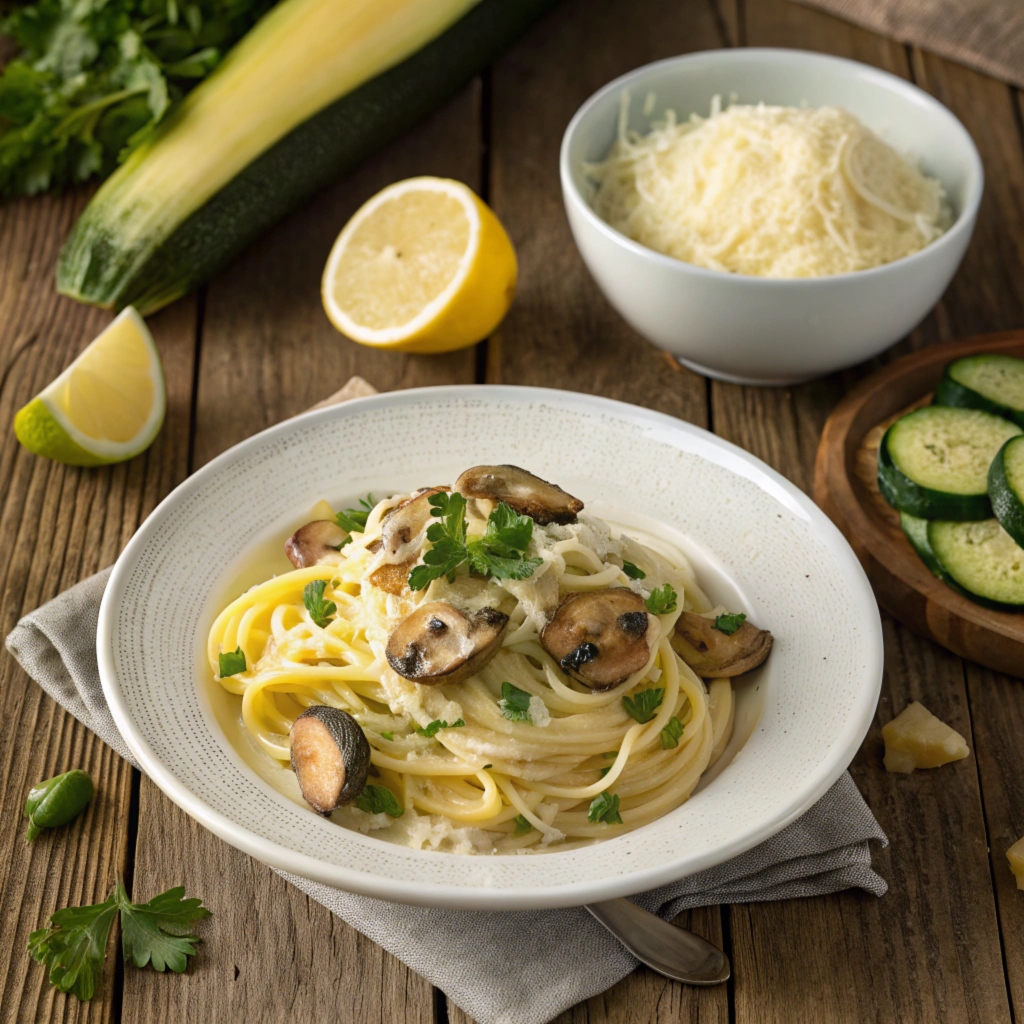Rediscovering Carbonara the Vegetarian Way
Carbonara is one of the most beloved pasta dishes in the world, known for its creamy texture, rich flavors, and simple yet elegant ingredients. However, here’s the challenge: traditional carbonara relies on guanciale (cured pork cheek) and Pecorino Romano cheese, making it off-limits for vegetarians. So, can you enjoy carbonara without meat? Absolutely!
As plant-based eating gains popularity, many have found creative ways to reinvent classic dishes. Consequently, vegetarian carbonara has emerged as a tasty alternative. By selecting the right ingredients and mastering key techniques, you can achieve a version as indulgent as the original. Thus, it proves that meat isn’t necessary to enjoy the signature flavor.
Furthermore, this guide will walk you through everything you need to know. From choosing the perfect meat-free substitutes to ensuring a silky-smooth sauce, you’ll discover expert tips to make a vegetarian carbonara that’s equally satisfying. Ready to cook? Let’s dive in! 🍝✨
Recipe: How to Make the Ultimate Vegetarian Carbonara
Now that we understand how vegetarian carbonara can be just as delicious as the original, it’s time to get cooking! Below is a detailed recipe, a breakdown of ingredients, and step-by-step instructions to help you master this dish at home.

Ingredients List for a Flavor-Packed Carbonara
To recreate the depth and richness of traditional carbonara, we’ll be using carefully selected vegetarian alternatives. Each ingredient is crucial in building flavor, texture, and creaminess.
| Ingredient | Quantity | Why It’s Important |
|---|---|---|
| Spaghetti or Fettuccine | 12 oz (340g) | The classic pasta base that holds the sauce well. |
| Mushrooms (shiitake or cremini) | 1 cup, sliced | A savory, umami-rich substitute for guanciale. |
| Smoked Tofu or Tempeh | ½ cup, cubed | Adds a chewy, bacon-like texture. |
| Olive Oil | 2 tbsp | Helps sauté the mushrooms and tofu. |
| Garlic | 2 cloves, minced | Enhances the overall flavor. |
| Vegetarian Parmesan (or Pecorino) | ¾ cup, grated | Brings the salty, cheesy depth. |
| Eggs (or silken tofu for vegan option) | 2 whole eggs (or ½ cup tofu) | Creates the creamy base of the sauce. |
| Nutritional Yeast (for extra cheesiness) | 1 tbsp | Adds a rich, nutty flavor. |
| Black Pepper | 1 tsp | Essential for the signature carbonara spice. |
| Salt | To taste | Balances all the flavors. |
| Pasta Water | ½ cup | Helps create the smooth, emulsified sauce. |
💡 Pro Tip: Use high-quality ingredients for the best results. Freshly grated cheese, organic eggs, and good olive oil make a huge difference in flavor!
Step-by-Step Cooking Instructions
Now that we have all the ingredients let’s bring this dish to life! Follow these easy steps to make the ultimate vegetarian carbonara:
1. Prepare the Meat-Free Guanciale Substitute
- Heat 1 tablespoon of olive oil in a large pan over medium heat.
- Add the sliced mushrooms and cubed smoked tofu (or tempeh).
- Sauté for 5-7 minutes until the mushrooms become golden brown and the tofu develops a slight crisp.
- Stir in the minced garlic, cooking for another 30 seconds until fragrant.
- Remove from heat and set aside.
2. Cook the Pasta
- Bring a large pot of salted water to a boil.
- Add the spaghetti (or preferred pasta) and cook according to package instructions until al dente.
- Before draining, reserve ½ cup of pasta water. This will help create the sauce.
3. Make the Creamy Sauce
- In a mixing bowl, whisk together:
- Eggs (or blended silken tofu for a vegan option)
- Grated vegetarian Parmesan
- Nutritional yeast (if using)
- Freshly ground black pepper
- Slowly add ¼ cup of warm pasta water, whisking constantly to temper the eggs.
4. Combine Everything
- Drain the pasta and immediately toss it into the pan with the mushrooms and tofu.
- Turn the heat to low and gradually pour in the egg-cheese mixture, stirring continuously to coat the pasta evenly.
- Add more pasta water, one tablespoon at a time, until the sauce reaches a smooth, creamy consistency.
5. Serve and Enjoy!
- Plate the pasta and sprinkle extra vegetarian Parmesan and black pepper on top.
- Serve immediately and enjoy your delicious homemade vegetarian carbonara!
💡 Pro Tip: Work quickly! Carbonara sauce should never be cooked over direct heat—the residual heat from the pasta gently thickens the sauce, creating a creamy texture without scrambling the eggs.
Tips for Achieving a Creamy, Authentic Texture
Even with vegetarian substitutes, you can still achieve the signature richness and creaminess that makes carbonara irresistible. Here are a few expert tips to ensure success:
✔ Use reserved pasta water wisely. The starch from the pasta helps emulsify the sauce, making it velvety smooth.
✔ Temper the eggs carefully. Slowly adding warm pasta water prevents them from scrambling.
✔ Don’t overcook the sauce. The heat from the pasta is enough to thicken it—no need for extra stovetop heat.
✔ Choose the right cheese. Freshly grated vegetarian Parmesan melts better than pre-packaged versions.
✔ Balance flavors with black pepper and salt. Traditional carbonara is all about simplicity, so seasoning is key!
Final Thoughts: Enjoying Carbonara the Vegetarian Way
Switching to a vegetarian lifestyle doesn’t mean sacrificing your favorite comfort foods! With the right ingredients and techniques, you can still enjoy a creamy, flavorful carbonara without any meat.
This vegetarian carbonara recipe demonstrates that a few smart swaps—like mushrooms for guanciale, vegetarian cheese, and silken tofu—can create an authentic and satisfying dish. Moreover, experimenting with different ingredients allows you to tailor the flavors to your preference. So, why not give it a try? Find your perfect balance, get creative, and enjoy a plate of this delicious Italian classic—meat-free yet just as indulgent. 🍝✨
Common Problems and Solutions in Making Vegetarian Carbonara

Even with a well-planned recipe, vegetarian carbonara isn’t always foolproof. Sometimes, the sauce turns out too runny, the flavors seem unbalanced, or the pasta becomes overcooked. However, there’s no need to worry! Every problem has a solution. Let’s dive into the most common issues and how to fix them so your carbonara is always creamy, flavorful, and perfectly textured.
Problem: Sauce Consistency Issues and How to Fix Them
One of the biggest challenges when making vegetarian or traditional carbonara is achieving that silky, creamy sauce without ending up with something too watery, too thick, or even worse—scrambled eggs.
Why This Happens:
1❌ Runny Sauce: Too much liquid or not enough cheese.
2❌ Thick & Clumpy Sauce: Overheating causes the eggs (or vegan substitute) to cook too quickly.
3❌ Scrambled Eggs Effect: Adding the sauce to too-hot pasta or cooking it over direct heat.
How to Fix It:
✔ For a runny sauce, Add more grated cheese or nutritional yeast to thicken it slightly. Let it sit for a minute before serving—carbonara sauce thickens as it rests.
✔ For a thick or clumpy sauce, stir in warm pasta water until it loosens. The starchy water helps create that velvety texture.
✔ To avoid scrambled eggs: Remove the pan from heat before adding the sauce. Stir constantly as you pour, and let the residual heat from the pasta gently cook the sauce.
Problem: Balancing Flavors Without Traditional Bacon
Without guanciale or bacon, vegetarian carbonara can sometimes lack the rich, smoky depth that makes the original version so delicious. So, how do you build flavor without meat?
Why This Happens:
1❌ Mushrooms, tofu, or tempeh don’t naturally have the same umami depth as cured pork.
2❌ Vegetarian versions might feel too light or one-dimensional.
3❌ The dish lacks the slight smokiness that makes carbonara special.
How to Fix It:
1✔ Boost Umami: Use shiitake mushrooms, miso paste, or a dash of soy sauce in your “bacon” substitute to add depth.
2✔ Introduce Smokiness: Add smoked paprika, liquid smoke, or smoked tofu to bring a subtle smoky element without overpowering the dish.
3✔ Enhance Saltiness: Vegetarian Parmesan or Pecorino is key. If using nutritional yeast, add a pinch of salt or tamari to enhance its cheesy flavor.
4✔ Use Black Pepper Generously: The freshly cracked black pepper’s sharp bite adds signature carbonara warmth and spice.
💡 Pro Tip: A small splash of white wine or lemon juice while sautéing mushrooms or tofu adds a bright, complex layer of flavor.
Problem: Overcooked Pasta and Maintaining Perfect Texture
Pasta texture can make or break a good carbonara. Overcooked pasta becomes mushy and fails to hold the sauce properly, while undercooked pasta leaves you with a chewy, unpleasant bite.
Why This Happens:
1❌ Leaving pasta in the water too long.
2❌ Not using enough water, causing uneven cooking.
3❌ Not draining quickly enough, leading to carryover cooking.
How to Fix It:
1✔ Cook Pasta Al Dente: Set a timer and check a minute before the recommended time—pasta should be firm but not crunchy.
2✔ Use Plenty of Water: Boil pasta in at least 4 quarts of water per 12 oz of pasta to ensure even cooking.
3✔ Drain Immediately: Don’t leave the pasta sitting in hot water—it will keep cooking! Instead, drain it quickly and toss it into the pan with the sauce.
💡 Pro Tip: Save your pasta water! A bit of starchy water helps emulsify the sauce and keeps the pasta from sticking together.
Final Thoughts: Mastering Vegetarian Carbonara Like a Pro
Making vegetarian carbonara can be just as satisfying and flavorful as the traditional version, as long as you focus on key elements like sauce consistency, seasoning, and pasta texture. By following these troubleshooting tips, you’ll create a dish that’s creamy, balanced, and downright delicious.
✅ For perfect sauce consistency: Use enough cheese and pasta water, stir continuously, and avoid overheating the sauce. If it becomes too thick, add a splash of warm pasta water to loosen it.
✅ For bold flavors without bacon: Incorporate umami boosters like mushrooms, smoked paprika, and soy sauce to mimic the depth of guanciale. A hint of liquid smoke or caramelized onions can enhance the overall taste.
✅ For perfectly cooked pasta: Stick to al dente, use plenty of boiling water, and drain it immediately to prevent overcooking. Moreover, reserving some pasta water ensures the sauce binds beautifully to the noodles.
Now that you’re equipped with these solutions, it’s time to cook up your best-ever vegetarian carbonara! Buon appetito! 🍝✨
Creative Variations and Serving Suggestions for Vegetarian Carbonara
Once you’ve mastered the classic version, why not experiment with new flavors? By incorporating seasonal vegetables, dairy-free alternatives, or creative sides, you can elevate your carbonara while keeping it fresh and exciting. Let’s dive into some delicious ways to customize your dish and make it even more satisfying!
Adding Seasonal Vegetables for Extra Nutrition and Flavor
Vegetables aren’t just for color—they add texture, sweetness, and nutritional value to your carbonara. Depending on the season, different veggies can complement the dish beautifully.
Best Vegetables to Add to Vegetarian Carbonara:
🌱 Spring & Summer:
- Asparagus: Lightly grilled or sautéed, asparagus adds a fresh, slightly crunchy contrast.
- Zucchini: Spiralized zucchini mixed with pasta makes for a lighter, fiber-rich meal.
- Cherry Tomatoes: Bursting with natural sweetness, they balance the sauce’s richness.
🍂 Fall & Winter:
- Roasted Butternut Squash: Its natural creaminess blends beautifully with carbonara sauce.
- Brussels Sprouts: Pan-seared for a crispy texture, they add an earthy depth.
- Mushrooms (Shiitake or Portobello): A natural umami booster, mushrooms mimic the savory bite of guanciale.
How to Incorporate Them:
1✔ Roast or sauté veggies before adding them to the pasta to enhance their natural flavors.
2✔ Cut them into bite-sized pieces to blend well with the sauce.
3✔ Don’t overdo it—choose one or two vegetables to maintain the dish’s creamy, indulgent texture.
💡 Pro Tip: Roasted garlic pairs wonderfully with vegetables in carbonara, adding a rich, caramelized flavor!
Vegan Adaptations: Dairy-Free and Gluten-Free Options
If you’re following a vegan or gluten-free diet, don’t worry—you can still enjoy a deliciously creamy carbonara! Here’s how:
Dairy-Free Cheese Alternatives
- 🧀 Nutritional Yeast: Provides a nutty, cheesy taste while being 100% plant-based.
- 🥥 Cashew Cream: Blended cashews with lemon juice and garlic mimic the creaminess of cheese.
- 🌱 Vegan Parmesan: Look for store-bought brands or make your own by blending cashews, garlic powder, and nutritional yeast.
Egg Substitutes for a Creamy Sauce
- 🥄 Silken Tofu: Blended with plant-based milk and turmeric, it creates a rich and creamy sauce.
- 🌾 Chickpea Flour + Water: Cooked gently, it thickens into a custard-like texture, similar to eggs.
- 🥛 Unsweetened Oat or Soy Cream: Helps achieve a smooth, dairy-free consistency.
Making It Gluten-Free
✅ Swap regular pasta for: Brown rice pasta, chickpea pasta, or zucchini noodles (zoodles).
✅ Use a thickener: Add a teaspoon of cornstarch to the sauce if you need extra creaminess.
💡 Pro Tip: Add a dash of white miso paste for extra umami in vegan carbonara enhances the flavors beautifully!
Conclusion: Embracing the Vegetarian Carbonara Revolution
Vegetarian carbonara isn’t just a substitute—it’s a delicious reinvention of a classic dish. By using high-quality ingredients, experimenting with flavors, and making smart adjustments, you can create a pasta that’s just as creamy, satisfying, and flavorful as the original. Additionally, incorporating umami-rich ingredients like mushrooms or smoked paprika enhances depth, while choosing the right cheese ensures authenticity. Moreover, mastering sauce consistency and pasta texture guarantees a perfect dish every time. So, why not try it today and enjoy an equally indulgent meat-free carbonara?
Moreover, the beauty of vegetarian carbonara lies in its versatility. The possibilities are endless, whether you stick to a simple, traditional version or enhance it with seasonal vegetables, dairy-free alternatives, or gluten-free pasta. Small tweaks—like adding smoked paprika for depth or nutritional yeast for cheesiness—can further elevate your dish.
So why not make this meat-free carbonara a regular favorite in your kitchen? Not only is it easy to prepare, but it’s also a perfect way to enjoy a comforting, indulgent meal while staying plant-based. Now, grab your ingredients and start cooking! 🍝✨
You May also be Interested in:
How Long Should I Grill Chicken to Make It Tender? A Complete Guide
What Type of Pasta Works Best for This Dish?
Authentic Carbonara Recipe: Ingredients, Tips & Global Variations

